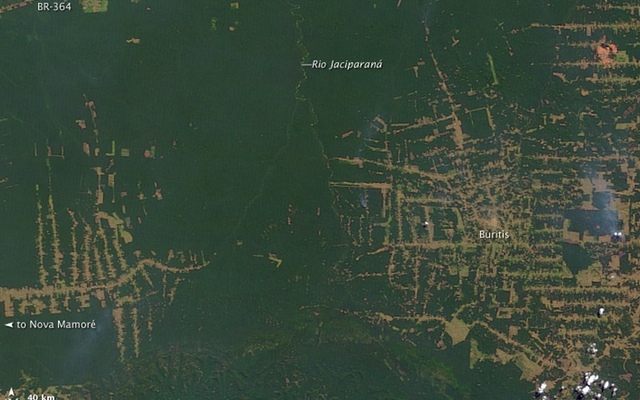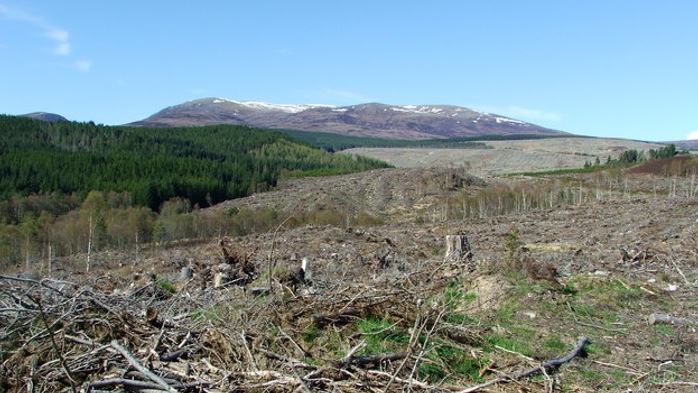Habitat fragmentation has harmful effects to world ecosystems. Image: Nick Haddad, NC State University
From boreal woods to tropical jungles, Earth's forests support an astonishing variety of life. It's no secret that humans have been steadily chipping away at these vibrant arboreal ecosystems for millennia, leaving fragmented habitats in their wake. But now, a new study published Friday in Science Advances has detailed the overarching severity of the resulting biodiversity loss, and its cumulative effect over long periods of time.The study, led by ecologist Nick Haddad, compiles an enormous survey of data collected over 35 years from five continents, representing a wide range of forest ecosystems. This approach provided a wide view, both geographically and temporally, from which to observe the ongoing effects of fragmentation. Unfortunately, the picture it painted was not pretty."The results were astounding," Haddad said in a North Carolina State University statement. "Nearly 20 percent of the world's remaining forest is the distance of a football field—or about 100 meters—away from a forest edge. Seventy percent of forest lands are within a half-mile of a forest edge. That means almost no forest can really be considered wilderness." Close contact with humans has repeatedly proved to be a biodiversity killer, so the fact that two thirds of the planet's forests are essentially in human backyards is troubling. Urban environments have many profound effects for nearby ecosystems, including the disruption of the local microclimate and the introduction of foreign species to the wild.Moreover, Haddad's team discovered that the steady isolation of small patches of forests creates an unpredictable ecological cascade effect over time. Species that are boxed up in one area cannot easily travel and colonize other forested patches, which leads to a drop in genetic diversity and increased risk of local extinction.In some rainforest environments, fragmentation gives an ecological boost to young trees, which kill off old-growth trees—organisms that, like coral reefs, have established their own intricate biomes. Another macro observation was that fragmented forests tended to shift the odds in favor of predators, which has far-reaching trophic repercussions, including reducing the fecundity of birds.
Close contact with humans has repeatedly proved to be a biodiversity killer, so the fact that two thirds of the planet's forests are essentially in human backyards is troubling. Urban environments have many profound effects for nearby ecosystems, including the disruption of the local microclimate and the introduction of foreign species to the wild.Moreover, Haddad's team discovered that the steady isolation of small patches of forests creates an unpredictable ecological cascade effect over time. Species that are boxed up in one area cannot easily travel and colonize other forested patches, which leads to a drop in genetic diversity and increased risk of local extinction.In some rainforest environments, fragmentation gives an ecological boost to young trees, which kill off old-growth trees—organisms that, like coral reefs, have established their own intricate biomes. Another macro observation was that fragmented forests tended to shift the odds in favor of predators, which has far-reaching trophic repercussions, including reducing the fecundity of birds. "I was blown away by the fact that these negative effects became even more negative with time," Haddad said. "Some results showed a 50 percent or higher decline in plant and animals species over an average of just 20 years, for example. And the trajectory is still spiraling downward."In their conclusion, Haddad and his colleagues warned that the situation is poised to get worse before it gets better. "The area of Earth's land surface devoted to cropland already occupies 1.53 billion hectares, and may expand 18 percent by the middle of this century," the team pointed out.This kind of unchecked expansion will come back to bite our own species hard, and indeed, it has already begun to pose serious existential challenges.Clearly, what's needed is aggressive restoration of woodland habitat, and the construction of forest corridors between isolated patches. Humans have deep evolutionary roots in these woodland environments, and have built modern civilization off their yields. It is past time that we yielded turf back to the multitudes of organisms that depend on the planet's forests, and in doing so, help secure our own future.
"I was blown away by the fact that these negative effects became even more negative with time," Haddad said. "Some results showed a 50 percent or higher decline in plant and animals species over an average of just 20 years, for example. And the trajectory is still spiraling downward."In their conclusion, Haddad and his colleagues warned that the situation is poised to get worse before it gets better. "The area of Earth's land surface devoted to cropland already occupies 1.53 billion hectares, and may expand 18 percent by the middle of this century," the team pointed out.This kind of unchecked expansion will come back to bite our own species hard, and indeed, it has already begun to pose serious existential challenges.Clearly, what's needed is aggressive restoration of woodland habitat, and the construction of forest corridors between isolated patches. Humans have deep evolutionary roots in these woodland environments, and have built modern civilization off their yields. It is past time that we yielded turf back to the multitudes of organisms that depend on the planet's forests, and in doing so, help secure our own future.
Advertisement
Advertisement
